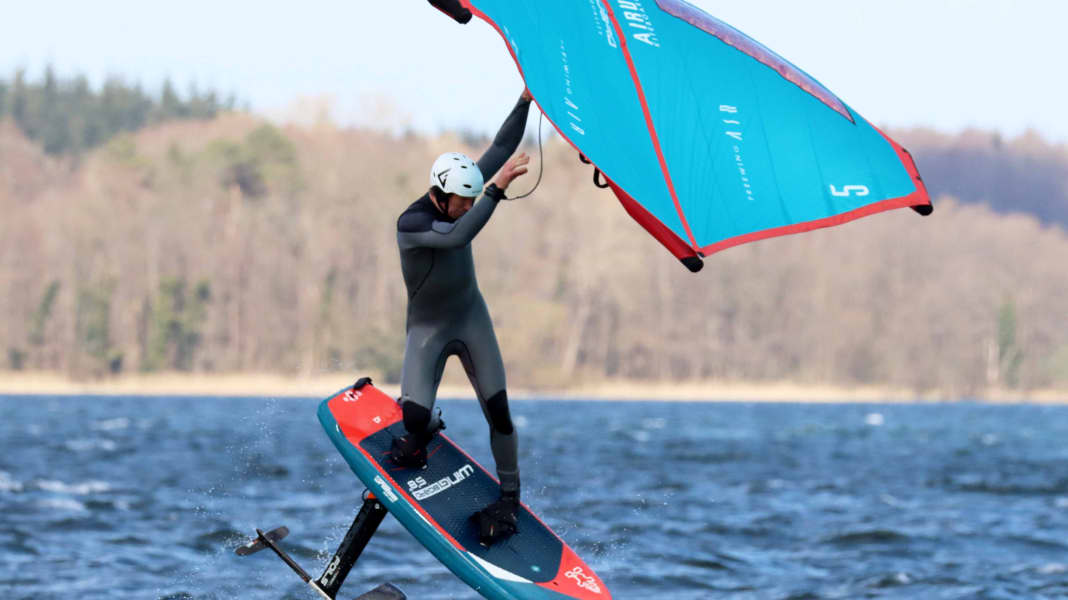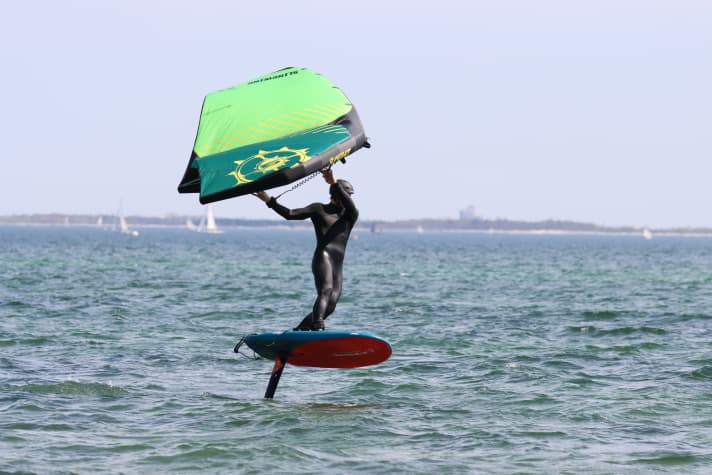
The Starboard Wingboard on land:
The Starboard Wingboard is available in four sizes, 69/88/115 and 140 litres, each in two designs - the standard Lite Tech design (989 to 1129 euros) and the Blue Carbon design, which is around 1.5 kilos lighter but twice as expensive at 2149 euros. While the 140 litre size is primarily aimed at pure wing beginners, the 88 litre size is intended to be a good all-round size for many wingsurfers, offering users weighing between 75 and 95 kilos enough buoyancy to be able to take off safely even in light winds, while still feeling compact for tricks and first jumps. At 6.5 kilos, our test size, the Wingboard 5'8 in the Blue Carbon design, was pleasantly light. It comes with wide straps from Airush, which offer good riding comfort and are very soft. Only those who have very large feet (> size 46) and are also travelling with thick shoes would like to be able to adjust the straps a little larger. As is usual with windsurf boards, Starboard uses thicker screws for the straps, which should benefit durability. For an 88-litre board, the 5'8 is slightly longer than comparably voluminous concepts from other brands at 173 centimetres. A lot of volume has been packed into the thick rails and the board has been visibly thinned out in the centre area.
You can see the most striking features of the Starboard Wingboard in our product clip. Take a look and subscribe to our YouTube channel .
On the water:
For an 88-litre board, the Starboard Wingboard 5'8 is comparatively stable in the water. This is partly due to the greater overall length, which makes the board less sensitive to load errors around the transverse axis, but also to the thick edges, which in turn ensure stability around the longitudinal axis. However, if you kneel on deck before starting off, your shins will inevitably come into contact with the less comfortable edge shape. Starting on the wingboard, on the other hand, is surprisingly harmonious, the pull of the wing is converted well into speed and, above all, if you stand on deck passively, i.e. without pumping, the Starboard Wingboard reaches take-off speed a little earlier than with shorter concepts, which often push more water in front of them in displacement mode. In the air, the riding characteristics are of course primarily determined by the foil used; we used two Starboard foils (E-Type 1700 & S-Type 1500) for the test, which harmonised wonderfully with the board. The light weight of the wingboard makes it easy to get airborne, and if you use the board with a fast high aspect wing, you can attempt your first jumps without any restrictions. We found the edge shape took some getting used to, especially when jibing - if you put your foot out of the loop onto the rail, you inevitably stand a little "uphill", i.e. with your toes higher than your heel.

Conclusion:
The Starboard Wingboard 5'8 in the Blue Carbon design is a convincing lightweight all-round board for riders weighing 70 to 95 kilos who already have some wing experience. The length is not as radically short as is usual with many other brands in the 90-litre class. This is a clear advantage when starting off and bobbing, but "more compact" is usually "better" when it comes to air rotations.
Light, stable & good planing behaviour
Relatively long
Edge shape when climbing
